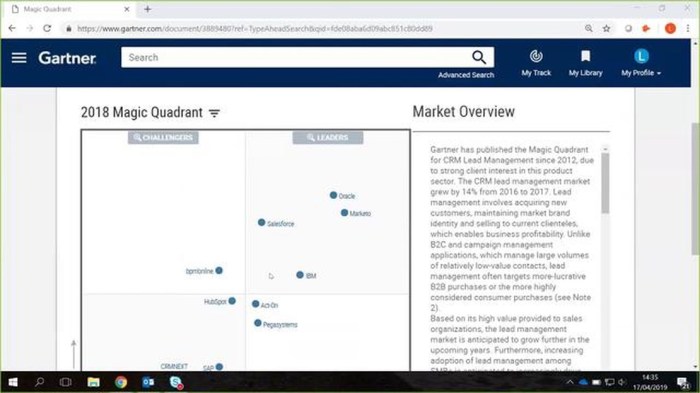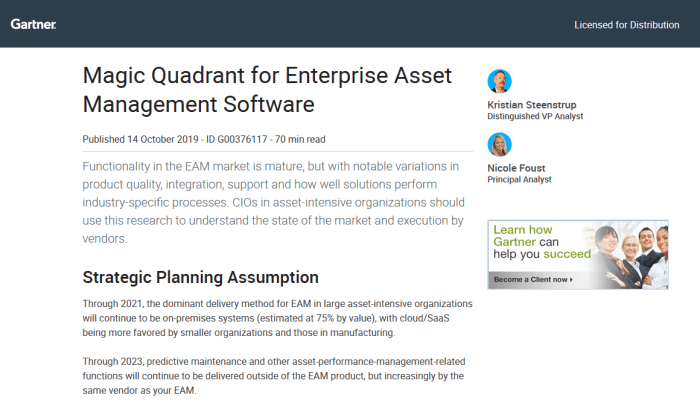Gartner Magic Quadrant Software Asset Management provides a crucial framework for understanding the competitive landscape in software asset management (SAM). This analysis helps organizations navigate the complex world of software licensing, compliance, and cost optimization. The report evaluates vendors based on their completeness of vision and ability to execute, offering valuable insights for businesses seeking to improve their SAM strategies and practices.
Understanding this quadrant is key for informed decision-making in a field increasingly critical for both budgetary and legal reasons.
The Gartner Magic Quadrant’s methodology involves rigorous analysis of vendors’ capabilities, market presence, and customer feedback. This comprehensive assessment allows organizations to compare different SAM solutions and select the best fit for their specific needs and priorities. Factors considered often include automation capabilities, reporting features, and the overall effectiveness of the vendor’s solution in managing software licenses across diverse environments.
The Gartner Magic Quadrant for Software Asset Management (SAM) is a highly influential report that provides a critical assessment of leading vendors in the SAM space. Understanding this report is crucial for organizations seeking to optimize their software investments, manage licensing compliance, and reduce IT costs. This comprehensive guide delves into the key aspects of the Gartner Magic Quadrant for SAM, explaining its methodology, interpreting its findings, and offering valuable insights for decision-making.
Understanding the Gartner Magic Quadrant Methodology
Gartner’s Magic Quadrant uses a rigorous methodology to evaluate vendors based on two key dimensions: Completeness of Vision and Ability to Execute. These dimensions are further broken down into numerous criteria, including:
Completeness of Vision:
- Market Understanding: The vendor’s understanding of current and future market trends, customer needs, and competitive landscape.
- Marketing Strategy: The effectiveness of the vendor’s marketing and sales strategies in reaching target audiences.
- Offering (Product) Strategy: The comprehensiveness and innovation of the vendor’s SAM solutions, including features, functionality, and integration capabilities.
- Business Model: The sustainability and scalability of the vendor’s business model, including pricing, licensing, and support.
- Vertical/Industry Strategy: The vendor’s focus on specific industries and their ability to tailor solutions to their unique needs.
- Innovation: The vendor’s commitment to research and development, leading to the introduction of new features and technologies.
- Geographic Strategy: The vendor’s global reach and ability to support customers in various regions.
Ability to Execute:
- Product/Service: The quality, functionality, and performance of the vendor’s SAM solutions.
- Overall Viability: The financial stability and long-term prospects of the vendor.
- Sales Execution/Pricing: The effectiveness of the vendor’s sales process and pricing strategies.
- Market Responsiveness/Record: The vendor’s ability to adapt to changing market conditions and customer feedback.
- Marketing Execution: The effectiveness of the vendor’s marketing campaigns and communication strategies.
- Customer Experience: The overall satisfaction of the vendor’s customers with their products and services.
- Operations: The efficiency and effectiveness of the vendor’s internal operations.
Based on these criteria, Gartner positions vendors into four quadrants: Leaders, Challengers, Visionaries, and Niche Players. Each quadrant represents a different level of performance and market positioning.
Interpreting the Gartner Magic Quadrant for SAM
The Magic Quadrant is not a ranking system, but rather a visual representation of vendor capabilities. While the “Leaders” quadrant is often considered the most desirable position, each quadrant has its own strengths and weaknesses. Organizations should carefully consider their specific needs and priorities when evaluating vendors.
Leaders:
Leaders demonstrate strong execution capabilities and a comprehensive vision for the future of SAM. They typically offer mature, feature-rich solutions with a proven track record of success.
Challengers:
Challengers possess strong execution capabilities but may have a less comprehensive vision than Leaders. They often offer competitive solutions at attractive price points.
Visionaries:, Gartner magic quadrant software asset management
Visionaries have a strong vision for the future of SAM but may lack the execution capabilities of Leaders or Challengers. They often focus on innovative technologies and emerging trends.
Niche Players:
Niche Players focus on specific segments of the SAM market, offering specialized solutions for particular customer needs. They may lack the broad market reach of Leaders or Challengers.
Key Considerations When Using the Gartner Magic Quadrant
While the Gartner Magic Quadrant is a valuable resource, it’s crucial to remember that it’s just one piece of the puzzle. Organizations should supplement the report with their own due diligence, including:
- Customer References: Speak to existing customers to get their firsthand experiences with the vendor’s solutions.
- Product Demos and Trials: Request demos and trials to assess the usability and functionality of the software.
- Pricing and Licensing: Carefully review the vendor’s pricing and licensing models to ensure they align with your budget and needs.
- Integration Capabilities: Evaluate the vendor’s ability to integrate with your existing IT infrastructure.
- Support and Maintenance: Assess the level of support and maintenance offered by the vendor.
Software Asset Management (SAM) Best Practices: Gartner Magic Quadrant Software Asset Management
Effective SAM goes beyond simply selecting a vendor. It requires a comprehensive strategy that encompasses various aspects of software lifecycle management. This includes:
- Discovery and Inventory: Identifying all software assets across your organization.
- License Optimization: Maximizing the utilization of existing licenses and minimizing waste.
- Compliance Management: Ensuring compliance with software vendor licensing agreements.
- Cost Management: Reducing software costs through better planning and procurement.
- Risk Management: Identifying and mitigating potential risks associated with software usage.
Frequently Asked Questions (FAQ)
- Q: How often is the Gartner Magic Quadrant for SAM updated? A: The Gartner Magic Quadrant for SAM is typically updated annually.
- Q: Is the Gartner Magic Quadrant a ranking? A: No, it’s a visual representation of vendor capabilities across two dimensions.
- Q: What are the key criteria used in the Gartner Magic Quadrant for SAM? A: Completeness of Vision and Ability to Execute, further broken down into numerous sub-criteria.
- Q: Should I only consider vendors in the Leaders quadrant? A: No, consider your specific needs and priorities when evaluating vendors across all quadrants.
- Q: Where can I access the Gartner Magic Quadrant for SAM? A: You typically need a Gartner subscription to access the full report. However, summaries and excerpts are often available online.
Conclusion
The Gartner Magic Quadrant for SAM provides a valuable framework for evaluating SAM vendors. However, it’s essential to conduct thorough due diligence and consider your organization’s unique needs before making a decision. By combining the insights from the Magic Quadrant with your own research, you can select a SAM solution that helps you optimize your software investments and achieve your business objectives.
Call to Action
Ready to optimize your software asset management strategy? Contact us today for a consultation to discuss your needs and explore the best solutions for your organization.

Source: shallbd.com
In conclusion, the Gartner Magic Quadrant for Software Asset Management serves as an indispensable resource for organizations looking to optimize their software investments and ensure compliance. By carefully considering the vendors’ positions within the quadrant, businesses can make informed decisions, ultimately leading to improved efficiency, reduced costs, and minimized legal risks. The insights provided by Gartner’s analysis empower organizations to proactively manage their software assets and achieve greater control over their IT landscape.
FAQ
What are the key criteria Gartner uses to evaluate SAM vendors?
Gartner evaluates vendors based on their completeness of vision and ability to execute. These broad categories encompass various sub-criteria, including product functionality, market responsiveness, customer support, and overall market impact.
How often is the Gartner Magic Quadrant for SAM updated?

Source: b2binfodaily.com
The Gartner Magic Quadrant for SAM is typically updated annually, reflecting the dynamic changes within the software asset management market.
Is the Gartner Magic Quadrant free to access?
No, access to the Gartner Magic Quadrant reports typically requires a paid subscription to Gartner’s research services.
What is the difference between “Leaders,” “Challengers,” “Visionaries,” and “Niche Players”?
These are the four quadrants in the Gartner Magic Quadrant. Leaders excel in both completeness of vision and ability to execute. Challengers are strong in execution but may have a less comprehensive vision. Visionaries have a strong vision but may lag in execution. Niche Players focus on a specific segment of the market.
